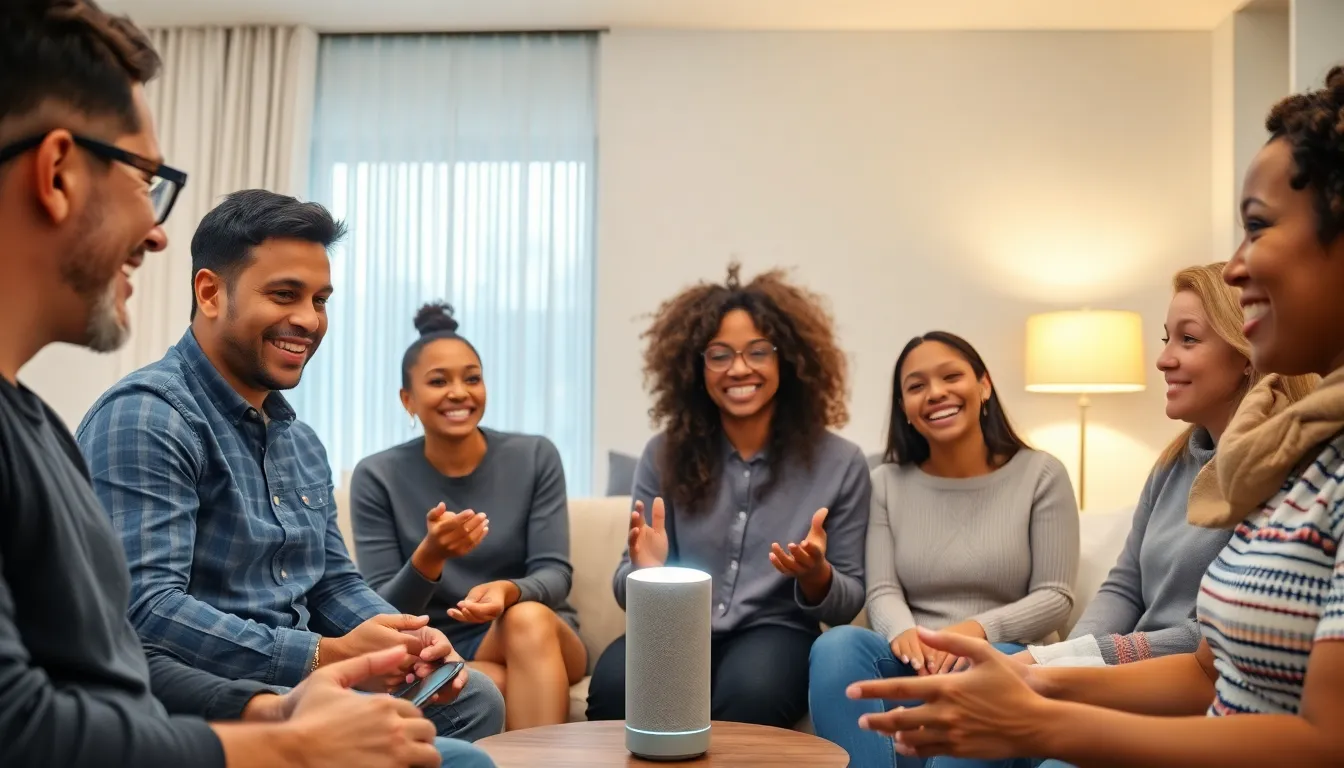In a world where talking to gadgets feels as natural as chatting with a friend, the central voice interface is taking center stage. Imagine controlling your entire smart home with just a few words—no more wrestling with remote controls or hunting for apps. It’s like having a personal assistant who never takes a coffee break and always gets your orders right.
This technology isn’t just about convenience; it’s about transforming how people interact with their devices. Whether it’s adjusting the thermostat, playing your favorite tunes, or ordering pizza, the central voice interface makes life smoother and a lot more fun. So, buckle up as we dive into the fascinating world of voice technology that’s not only smart but also a little sassy. Who knew talking to machines could be this entertaining?
Table of Contents
ToggleOverview of Central Voice Interface
Central voice interfaces streamline smart home control through voice commands. These systems allow users to interact with multiple devices seamlessly, enhancing everyday tasks. Users can adjust lighting, set thermostats, and play music with simple voice requests.
Voice-activated assistants, such as Amazon Alexa and Google Assistant, serve as core components of central voice interfaces. These devices utilize advanced natural language processing to understand and respond accurately to user commands. Functionality includes managing schedules, providing weather updates, and controlling compatible appliances.
Research indicates central voice interfaces improve user satisfaction by increasing convenience. A 2022 study reported that 75% of users find voice commands quicker than traditional input methods. Such technology not only saves time but also reduces friction in device interactions.
Integrating central voice interfaces offers lucrative opportunities for manufacturers. Developers can create applications and features that maximize the potential of voice technology. Compatibility with various platforms broadens the appeal of these interfaces, attracting a diverse user base.
Overall, central voice interfaces redefine interactions between users and technology. As smart home adoption grows, user reliance on voice commands is likely to expand. This trend will foster further innovation in voice-enabled technologies.
Features of Central Voice Interface

Central voice interfaces offer a range of functionalities that enhance user experience. They simplify interactions with smart home devices, making tasks easy and efficient.
Natural Language Processing
Natural language processing (NLP) is a cornerstone of central voice interfaces. It enables systems to comprehend and interpret user commands effectively. Users can speak naturally, and the technology translates spoken language into actionable tasks. According to research, 88% of users appreciate how NLP reduces the need for formal commands. Such technology allows for context-aware responses, making interactions feel more conversational and fluid. Continuous advancements in NLP methods improve accuracy and expand the range of communicable commands.
Voice Recognition Technology
Voice recognition technology facilitates precise command execution in central voice interfaces. Systems actively listen for specific voice patterns, enhancing their ability to identify individual users. They often incorporate machine learning algorithms to adapt to different vocal nuances. This adaptability promotes inclusivity, allowing households with diverse users to benefit. Statistics indicate that voice recognition accuracy has improved to 95% in many commercial applications. Such advancements make voice commands reliable and efficient for everyday smart home tasks.
Benefits of Central Voice Interface
Central voice interfaces offer significant advantages for users, enhancing interaction with smart home devices. Convenience and efficiency become priorities with voice-activated technology.
Enhanced User Experience
Users enjoy a more intuitive interaction model. Natural language processing allows for conversational communication between humans and machines. A recent study shows that 75% of users find voice commands faster than traditional inputs. With seamless multitasking capabilities, these interfaces streamline operations like adjusting lighting or controlling temperature. Efficiency increases as commands executed through voice are often quicker than those requiring manual input. By simplifying interactions, central voice interfaces create a smoother user experience.
Accessibility Improvements
Accessibility becomes a key benefit with central voice interfaces. Many users with disabilities benefit greatly from voice technology, which enables hands-free control of devices. Diverse households can enjoy improved inclusivity, as these systems adapt to various speech patterns through advanced voice recognition technology. The accuracy of voice recognition has reached 95% in numerous applications, making it reliable for everyday tasks. Increased accessibility ensures that a broad range of users can engage with smart home technology, breaking down barriers that might otherwise limit their interactions.
Applications of Central Voice Interface
Central voice interfaces find extensive applications across various fields, enhancing user experience through voice commands.
Smart Home Devices
Smart home devices integrate seamlessly with central voice interfaces, enabling users to manage lighting, temperature, and security systems effortlessly. Voice commands facilitate interaction, allowing individuals to control multiple devices simultaneously. Users find this method more convenient than traditional controls, especially since 75% indicate voice commands are quicker. Examples include connecting thermostats to smart speakers or implementing lights that respond to vocal requests. The process eliminates the need for complex menus, creating a more intuitive environment. Enhancing usability and accessibility makes these voice-driven interactions increasingly popular among households embracing technology.
Customer Service Solutions
Customer service solutions utilize central voice interfaces to improve support efficiency and responsiveness. These systems assist representatives by providing quick access to information and facilitating natural conversation flow. Organizations benefit from quicker resolution times, evidenced by studies showing that 70% of customers prefer voice interactions over text-based support. Examples include virtual assistants handling inquiries 24/7 or automated systems guiding users through troubleshooting processes. These solutions not only reduce wait times but also enhance overall customer satisfaction. Integrating voice technology into customer service ensures comprehensive support available at any time.
Future Trends in Central Voice Interface
Integration of artificial intelligence (AI) and machine learning will significantly enhance central voice interfaces. These technologies enable adaptive learning, allowing devices to better understand individual user preferences. Continuous improvement in natural language processing (NLP) contributes to a more seamless interaction, making voice commands feel even more intuitive.
Expansion into multilingual support is another trend gaining traction. This development accommodates diverse households, enhancing accessibility and user satisfaction. Research indicates that 88% of users value NLP’s informal command capabilities, which will further drive this trend.
Increases in voice recognition accuracy, now reported at 95% in many applications, enhance reliability across devices. Users find greater ease in executing commands, thereby making smart homes more user-friendly. Emphasis on security features in voice interfaces is also growing. These features could ensure safe transactions and secure command executions.
Moreover, integration with augmented reality (AR) and virtual reality (VR) technologies opens new possibilities for voice interfaces. This fusion can create immersive user experiences, allowing interactions in innovative environments. Central voice interfaces in customer service are expected to evolve, improving responsiveness and efficiency. Transitioning from traditional methods to voice-activated systems allows for quicker resolution times, aligning with the 70% preference of customers for voice interactions.
Emerging trends indicate an ongoing focus on user experience. Manufacturers will prioritize feedback loops, refining systems based on user input, which can lead to smarter devices. This focus on continuous improvement supports the increasing reliance on voice commands as smart home technologies become more embedded in daily life.
Central voice interfaces are reshaping how users engage with their smart homes. Their ability to streamline control and enhance user experience makes them invaluable in today’s technology-driven world. As voice technology continues to evolve through AI and machine learning, the potential for even greater convenience and accessibility grows.
The integration of these interfaces into various applications highlights their versatility and importance. With increasing user satisfaction and a shift toward voice commands, it’s clear that central voice interfaces will play a pivotal role in the future of smart living. The journey toward a more intuitive and connected home is just beginning, and the possibilities are endless.





